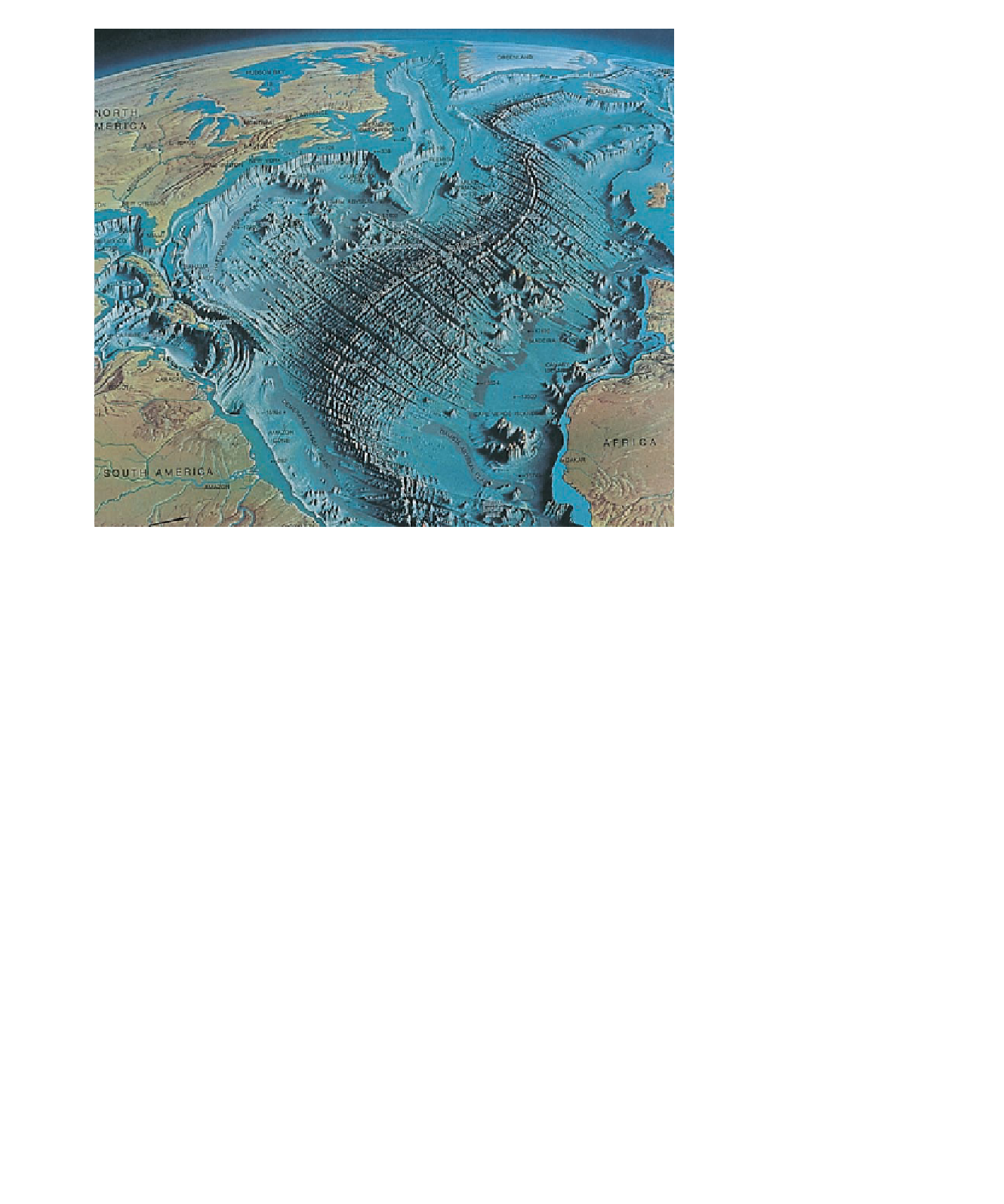Geology Reference
In-Depth Information
continental crust is 3.96 bil-
lion years old. Although geolo-
gists do not universally accept
the idea of thermal convection
cells as a driving mechanism
for plate movement, most ac-
cept that plates are created at
oceanic ridges and destroyed
at deep-sea trenches, regard-
less of the driving mechanism
involved.
the Confi rmation of
Seafl oor Spreading
For many geologists, the pa-
leomagnetic data amassed in
support of continental drift
and seafloor spreading were
convincing. Results from the
Deep-Sea Drilling Project (see
Chapter 9) confirmed the in-
terpretations made from earlier
paleomagnetic studies. Cores of
deep-sea sediments and seismic
profi les obtained by the
Glomar
Challenger
and other research
vessels have provided much of
the data that support the sea-
fl oor spreading theory.
According to this theory, oceanic crust continuously
forms at mid-oceanic ridges, moves away from these ridges
by seafl oor spreading, and is consumed at subduction zones.
If this is the case, then oceanic crust should be youngest at
the ridges and become progressively older with increasing
distance away from them. Moreover, the age of the oceanic
crust should be symmetrically distributed about the ridges.
As we have just noted, paleomagnetic data confirm these
statements. Furthermore, fossils from sediments overlying
the oceanic crust and radiometric dating of rocks found
on oceanic islands both substantiate this predicted age
distribution.
Sediments in the open ocean accumulate, on aver-
age, at a rate of less than 0.3 cm in 1000 years. If the ocean
basins were as old as the continents, we would expect deep-
sea sediments to be several kilometers thick. However, data
from numerous drill holes indicate that deep-sea sedi-
ments are, at most, only a few hundred meters thick and
are thin or absent at oceanic ridges. Their near-absence at
the ridges should come as no surprise because these are the
areas where new crust is continuously produced by volca-
nism and seafl oor spreading. Accordingly, sediments have
had little time to accumulate at or very close to spreading
ridges where the oceanic crust is young; however, their
thickness increases with distance away from the ridges
(
◗
Figure 2.11
Topography of the Atlantic Ocean Basin Artistic view of what the Atlantic Ocean basin
would look like without water. The major feature is the Mid-Atlantic Ridge, an oceanic ridge system that is
longer than 65,000 km and divides the Atlantic Ocean basin in half. It is along such oceanic ridges that
the seafl oor is separating and new oceanic crust is forming from upwelling magma in Earth's interior.
How could Hess's hypothesis be confirmed? Magnetic
surveys of the oceanic crust revealed a pattern of striped
magnetic anomalies
(deviations from the average strength
of Earth's present-day magnetic field) in the rocks that are
both parallel to and symmetric around the oceanic ridges
(
Figure 2.12). A positive magnetic anomaly results when
Earth's magnetic field at the time of oceanic crust forma-
tion along an oceanic ridge summit was the same as today,
thus yielding a stronger than normal (positive) magnetic
signal. A negative magnetic anomaly results when Earth's
magnetic field at the time of oceanic crust formation
was reversed, therefore yielding a weaker than normal
(negative) magnetic signal.
Thus, as new oceanic crust forms at oceanic ridge sum-
mits and records Earth's magnetic fi eld at the time, the previ-
ously formed crust moves laterally away from the ridge. These
magnetic stripes therefore represent times of normal and
reversed polarity at oceanic ridges (where upwelling magma
forms new oceanic crust), and conclusively confirm Hess's
theory of seafl oor spreading.
One of the consequences of the seafloor spreading
theory is its confi rmation that ocean basins are geologically
young features whose openings and closings are partially
responsible for continental movement (
◗
Figure 2.13). Ra-
diometric dating reveals that the oldest oceanic crust is some-
what younger than 180 million years old, whereas the oldest
◗
◗
Figure 2.14).

Search WWH ::

Custom Search